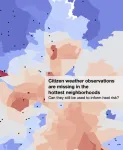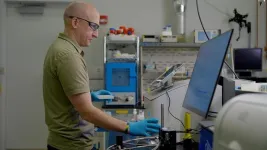(Press-News.org) DURHAM, N.C. -- There’s a strong chance that last week’s scorching temperatures were even hotter than reported for those living in underserved urban areas.
It’s been well established that more impoverished areas within cities are typically hotter than their wealthier neighborhoods. Dubbed “urban heat islands,” these communities have more buildings, less vegetation and somewhat higher population density, which combine to produce the heating effect.
New research from environmental engineers at Duke University has shown that citizen science tools used to gauge heat in these urban areas likely understate the problem of heat islands. The researchers also suggest a statistical method to improve estimates of urban heat.
The research appeared online June 17 in the journal Environmental Science and Technology Letters.
“The poorest areas of a city also tend to have the fewest number of weather stations to pull data from, so if we’re going to rely on their data, we either need to add more ground sensors or try to adjust for the missing data,” said Zach Calhoun, a civil and environmental engineering PhD student at Duke. “While having accurate temperature data might be important for residents going on their day-to-day business, it’s especially important for policymakers relying on the data to make well-informed decisions.”
“Extreme heat also leads to poor air quality, and the resulting impacts on respiratory and cardiovascular health should be monitored for the benefit of all,” added Marily Black, public health scientist for Underwriter’s Laboratory (UL) Chemical Insights Research Institute and coauthor of the paper. “This is especially true for the vulnerable in urban areas such as children and those who are economically disadvantaged.”
This data comes from the popular weather website Weather Underground, which was founded in 1995 as an offshoot of the University of Michigan’s internet weather database. It works by pulling data not just from official government weather stations, which are relatively sparse, but from weather stations set up by citizen scientists essentially in their own backyards. Today, Weather Underground receives data from more than 250,000 of these personal weather stations. In 2012, it was acquired by The Weather Channel, which also relies on this network of private stations.
While not exorbitantly expensive, personal weather stations cost several hundred dollars each. As one might expect, they’re more commonly purchased and set up in wealthier neighborhoods than in poorer ones. And that can cause issues when relying on a large number of them for weather information.
“Some of the sensors may be a bit off, but if you put a lot of them together, the aggregate data is pretty reliable,” said Mike Bergin, the Sternberg Family Professor of Civil & Environmental Engineering at Duke. “More data is good data. And less data is bad data.”
The researchers hypothesized that the poorest, hottest areas of a city don’t have nearly as many personal weather stations -- if they even have any at all. To address this problem, there are two possible solutions: either install more weather stations or figure out a way to correct for the lack of data.
Statistics to the rescue.
Working with David Carlson, assistant professor of civil and environmental engineering at Duke, the group pulled four years of data for the entire state of North Carolina from Weather Underground’s servers. They then mapped out where those stations are set up and compared their numbers to each area’s median income.
Unsurprisingly, there was a strong correlation between income and data, with more stations being set up in areas with higher median incomes. The researchers then did some statistical gymnastics and applied that same correlation to their trove of temperature data.
“This was a clever trick that Zach thought of to generate more accurate heat readings,” said Carlson. “But then there was the question of whether or not this correction actually creates more realistic heat maps or not.”
To validate their approach, the researchers turned to the National Integrated Heat Health Information System (NIHHIS). In 2021, the federal organization chose 15 locations for their NIHHIS-CAPA HeatWatch Campaign, where large groups of scientists and community volunteers took multiple heat and humidity readings throughout a single day across entire cities. Fortunately, both Raleigh and Durham, North Carolina were part of the project.
The team took Weather Underground’s readings for Durham on that same 2021 day and applied their statistical correction across the city. They found that their results across the entire city -- and, most importantly, in the areas with few or no personal weather station data -- were much closer to the HeatWatch campaign’s data.
These were also some of the hottest parts of the city, with temperatures exceeding what Weather Underground and The Weather Channel reported.
“Our work shows that you can make corrections and get better estimates of urban heat islands through these types of methods,” said Carlson. “It also highlights the need for additional weather stations so we’re aware of just how much hotter the summer is for the poorest members of our community.”
This research was supported through a collaboration with the Underwriter’s Laboratory (UL).
CITATION: “Refining Citizen Climate Science: Addressing Preferential Sampling for Improved Estimates of Urban Heat,” Zachary D. Calhoun, Marilyn S. Black, Mike Bergin, and David Carlson. Environmental Science and Technology Letters, June 17, 2024. DOI: 10.1021/acs.estlett.4c00296
Link: https://pubs.acs.org/doi/10.1021/acs.estlett.4c00296
# # #
END
For many urban residents, it’s even hotter than their weather app says
Statistical model adjusts temperature data and finds urban areas with few weather stations are even hotter than reported
2024-06-25
ELSE PRESS RELEASES FROM THIS DATE:
Bladder buzz: technologies to improve bladder surgery and monitoring
2024-06-25
A functional, healthy bladder is something that many of us take for granted. Yet millions of Americans deal with bladder issues, ranging from temporary inconveniences to long-lasting conditions. While many bladder disorders can be managed with non-invasive solutions, some conditions may require surgery to restore bladder function.
In patients with major bladder issues, a cystectomy may need to be performed. In this procedure, some or all of the bladder is removed (reasons for this may include acute trauma or bladder cancer). Sometimes, to compensate for the loss of tissue, the bladder is augmented (made larger), typically with ...
Half of world’s lakes are less resilient to disturbance than they used to be
2024-06-25
American Geophysical Union
Press Release 24-27
For Immediate Release
25 June 2024
This press release is available online at: https://news.agu.org/press-release/worlds-lakes-less-resilient-climate-pollution/
AGU press contact:
Rebecca Dzombak, news@agu.org (UTC-4 hours)
Contact information for the researchers:
Ke Zhang, Chinese Academy of Sciences, kzhang@niglas.ac.cn (UTC+8 hours)
WASHINGTON — Nearly half of the world’s large lakes have lost resilience, or the ability to bounce back after an abrupt disturbance, in recent ...
International trial introduces another curative option for sickle cell disease
2024-06-25
Vanderbilt University Medical Center (VUMC) researchers are touting data from a multicenter, international phase 2 clinical trial showing a new, curative treatment for sickle cell disease (SCD).
The therapy, nonmyeloablative haploidentical bone marrow transplant (BMT) with thiotepa and posttransplant cyclophosphamide (PTCy), is proving to have equivalent efficacy and one-fifth the cost as recently FDA-approved myeloablative gene therapy options, according to Michael DeBaun, MD, MPH, director of the Vanderbilt-Meharry Center ...
Study reveals potential therapeutic role of sodium valerate in reducing binge drinking
2024-06-25
In a significant finding, researchers from The Jackson Laboratory (JAX) and UConn Health have discovered that sodium valerate, a short-chain fatty acid produced by gut microbes, can dramatically reduce binge drinking behavior and blood ethanol concentration in mice. The study, reported June 17 in Microbiome, offers promising insights into the gut-brain axis and presents a novel therapeutic approach for excessive alcohol use.
We are interested in physiological addiction genetics and genomics to identify new drug targets for treating addiction/overdose.
The research team, led by Yanjiao Zhou, M.D., ...
Your future medications could be personalized for you on a 3D printer
2024-06-25
Chocolate-flavored pills for children who hate taking medicine.
Several drugs combined into one daily pill for seniors who have trouble remembering to take their medications.
Drugs printed at your local pharmacy at personalized dosages that best suit your health needs.
These are just a few potential advantages of 3D drug printing, a new system for manufacturing drugs and treatments on-site at pharmacies, health care facilities and other remote locations.
In 2015, the Food and Drug Administration approved the first 3D-printed drug, Spritam ...
Study finds foreign-born CEOs likelier to acquire international targets, including in their birth country
2024-06-25
Toronto - New research shows that CEOs who have moved away from their country of origin have a significantly higher tendency to make acquisitions internationally, with a preference for targets in their birth country or in countries that once colonized it.
“Foreign-born CEOs are taking an increasing leadership role in the corporate world,” says researcher Ron Shalev, an associate professor of accounting at the University of Toronto Scarborough who is cross-appointed to U of T’s Rotman School of Management. “In our sample, 24 per ...
For better loan terms, find a partner
2024-06-25
Shoppers browsing through blouses and blenders at Target know they can also quaff a cappuccino at one of more than 1,700 Starbucks cafeshoused within Targets. The strategic alliance benefits both corporations by helping them reach new markets, boost their brands, and add incremental sales.
Collaborative partnerships such as this have grown at a pace of 3,600 per year, according to the SDC Platinum database. That’s partly because companies in alliances can gain access to new technologies and customers while keeping their autonomy.
New research from Texas McCombs highlights ...
How uncertainty builds anxiety
2024-06-25
Alfred Hitchcock observed that “There is no terror in the bang, only in the anticipation of it.” A common way to build suspense in a movie scene is for the audience to know something bad is going to happen, but not when it is going to happen. But how does uncertainty work to ratchet up our anxiety? In a recent paper in the journal Computational Psychiatry, researchers at the University of California, Davis, Department of Psychology take a deeper look into what builds fear.
Not knowing when something will happen can cause anxiety, but until ...
Adolescents today are more satisfied with being single
2024-06-25
Young people aged 14 to 20 years are nowadays more satisfied with being single than their counterparts ten years ago. This is the conclusion of a study undertaken by the Institute of Psychology at Johannes Gutenberg University Mainz (JGU). "It seems that today's adolescents are less inclined to pursue a romantic relationship. This could well be the reason for the increased singlehood satisfaction," said psychologist Dr. Tita Gonzalez Avilés, lead author of the recent study. Growing numbers of people are living as ...
Researchers discover new flat electronic bands, paving way for advanced quantum materials
2024-06-25
In a study published in Nature Communications June 19, a team of scientists led by Rice University’s Qimiao Si predicts the existence of flat electronic bands at the Fermi level, a finding that could enable new forms of quantum computing and electronic devices.
Quantum materials are governed by the rules of quantum mechanics, where electrons occupy unique energy states. These states form a ladder with the highest rung called the Fermi energy.
Electrons, being charged, repel each other and move in correlated ways. ...
LAST 30 PRESS RELEASES:
How human interaction drove evolution to make bears less aggressive
National Poll: Few parents offer teens guidance on healthy eating during holiday season
Cannabis derivatives could provide new ovarian cancer treatments
Raising strong yeast as a petroleum substitute
Clues to the origin of hot Jupiters hidden in their orbits
Canada’s reduced pledge to Global Fund will impact domestic health
1 in 4 children with major traumatic injuries not cared for in pediatric trauma centres
Duke and Duke-NUS’ joint cross-population research to uncover "East-West" differences in disease and care
Scientists to ‘spy’ on cancer- immune cell interactions using quantum technology breakthrough
Tech savvy users have most digital concerns
Making lighter work of calculating fluid and heat flow
Normalizing blood sugar can halve heart attack risk
Lowering blood sugar cuts heart attack risk in people with prediabetes
Study links genetic variants to risk of blinding eye disease in premature infants
Non-opioid ‘pain sponge’ therapy halts cartilage degeneration and relieves chronic pain
AI can pick up cultural values by mimicking how kids learn
China’s ecological redlines offer fast track to 30 x 30 global conservation goal
Invisible indoor threats: emerging household contaminants and their growing risks to human health
Adding antibody treatment to chemo boosts outcomes for children with rare cancer
Germline pathogenic variants among women without a history of breast cancer
Tanning beds triple melanoma risk, potentially causing broad DNA damage
Unique bond identified as key to viral infection speed
Indoor tanning makes youthful skin much older on a genetic level
Mouse model sheds new light on the causes and potential solutions to human GI problems linked to muscular dystrophy
The Journal of Nuclear Medicine ahead-of-print tip sheet: December 12, 2025
Smarter tools for peering into the microscopic world
Applications open for funding to conduct research in the Kinsey Institute archives
Global measure underestimates the severity of food insecurity
Child survivors of critical illness are missing out on timely follow up care
Risk-based vs annual breast cancer screening / the WISDOM randomized clinical trial
[Press-News.org] For many urban residents, it’s even hotter than their weather app saysStatistical model adjusts temperature data and finds urban areas with few weather stations are even hotter than reported






